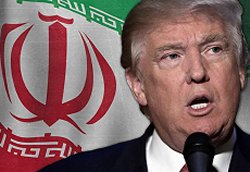
|
- Iran: Eight Prisoners Hanged on Drug Charges
- Daughter of late Iranian president jailed for ‘spreading lies’ - IRAN: Annual report on the death penalty 2016 - Taheri Facing the Death Penalty Again - Dedicated team seeking return of missing agent in Iran - Iran Arrests 2, Seizes Bibles During Catholic Crackdown
- Trump to welcome Netanyahu as Palestinians fear U.S. shift
- Details of Iran nuclear deal still secret as US-Tehran relations unravel - Will Trump's Next Iran Sanctions Target China's Banks? - Don’t ‘tear up’ the Iran deal. Let it fail on its own. - Iran Has Changed, But For The Worse - Iran nuclear deal ‘on life support,’ Priebus says
- Female Activist Criticizes Rouhani’s Failure to Protect Citizens
- Iran’s 1st female bodybuilder tells her story - Iranian lady becomes a Dollar Millionaire on Valentine’s Day - Two women arrested after being filmed riding motorbike in Iran - 43,000 Cases of Child Marriage in Iran - Woman Investigating Clinton Foundation Child Trafficking KILLED!
- Senior Senators, ex-US officials urge firm policy on Iran
- In backing Syria's Assad, Russia looks to outdo Iran - Six out of 10 People in France ‘Don’t Feel Safe Anywhere’ - The liberal narrative is in denial about Iran - Netanyahu urges Putin to block Iranian power corridor - Iran Poses ‘Greatest Long Term Threat’ To Mid-East Security |
Wednesday 20 July 2011Sanctions spark Iran currency fluctuations
imposed because of Iran’s nuclear programme are causing fluctuations in the local currency market as a shortage of foreign exchange bites, economists say. One US dollar bought IR11,640 on Wednesday on the open market, down from IR12,000 a month ago, although this was higher than the IR10,700 at the beginning of the year. “The central bank is short of hard currency because of sanctions which have disrupted withdrawal of money from overseas banks,” says a reform-minded economist connected to Iran’s financial organisations. Over the past decade, Iran’s central bank, which channels more than 90 per cent of hard currency into the local market, has employed a managed float system to support a single rate against hard currencies, notably the US dollar. Usually when the rial shows signs of weakening the bank pumps foreign currency into the market to bring rates down. But sometimes the authorities choose to weaken the national currency intentionally by withholding the supply of hard currency to earn more rial-denominated income when the government faces a budget deficit. This time, however, economic analysts believe it is not the central bank that is behind the market instability. Rather, the market is undersupplied with foreign exchange, the analysts say. The current ups and downs are an indication of the difficulties Iran is facing in dealing with restrictions on money transfers. “The central bank occasionally resorts to its reserves held inside the country to prevent a huge jump in prices. But it may not be long before we see a real crisis,” says a former financial official. The currency market saw similar fluctuations last September but the central bank quickly managed to stabilise the market. As of January, however, the rial started weakening against the dollar and fell 15 per cent in mid-June to reach IR12,500. The central bank devalued the rial by 10 per cent last month to prevent a two-tier rate system developing and to help reduce the gap between the official rate and the market rate. But the differential has not completely disappeared. Traders in the open market currently charge about 9 per cent more than the official bank rate. On Tuesday, Mahmoud Bahmani, Iran’s central bank governor, said that one of his main priorities remains to prevent two rates developing. Mr Bahmani vowed to “eliminate middle men” from the market. Meanwhile, analysts believe the government is trying to make the best use of the fluctuations to meet deficits, notably in paying the rial equivalent of $5bn a month in cash handouts to most Iranians. The payments were introduced last year to compensate for a cut in state subsidies on basic commodities. For the first time, the government has announced a one-week delay in the next transfer, fuelling fears among ordinary Iranians that the regime may be having difficulty making the payments. Mohammad Khoshchehreh, an economist who is close to anti-government fundamentalists, is one of those who believe the currency fluctuations are being fuelled by the government to enable it to meet its monthly commitments. “This is a short-term achievement which will have inflationary impacts in the medium term,” he says. Earlier this year, the government also introduced a series of regulations that has reduced the flow of rials into the banking system and further confused the market. Banks have been forced to lower the interest rates they offer depositors in order to reduce the rates at which they lend to encourage production. But in practice, analysts believe, the volume of new deposits in banks has declined as people prefer to buy gold coins or hard currency. Source: FT |






